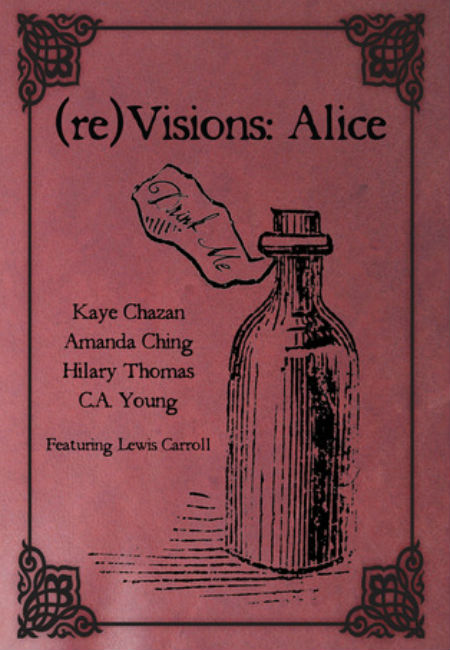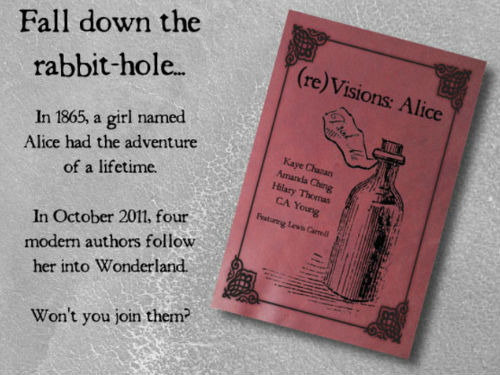
This is the first in a series of interviews with the (re)Visions: Alice that I published on a now sadly defunct writing site back in 2012. I hope you enjoy discovering more about the authors behind these remarkably imaginative re-imagined tales.
Kaye Chazan describes herself on her blog as “a writer of alternate history, faerie tales, those sidestepped worlds just out of your peripheral vision…” Her novelette, What Aelister Found Here, which is one of the four stories included in Candlemark and Gleam’s (re)Visions: Alice reflects this love of realities a phase or two out of sync with our own.
It takes its readers on a wonderful journey into Victorian London through the eyes of Aelister, a prepossessed teenage boy of singular focus who decides to forge a new life when his old one doesn’t agree with him.
It’s success as part of the imaginative (re)Visions: Alice project has led to further involvement with Candlemark & Gleam for Kaye who is excited about the doors that have opened for her since the book’s publication.
I interviewed Kaye about her love of imagining worlds close to but not quite our own and many other things beside as talked about her involvement in this wonderful project.
(1) What have you written prior to this and how did you come to be involved in the (re)Visions: Alice project? Was it a natural fit for you as a writer?
I think the project was an ideal fit for me! I’ve always been interested in intertextuality and interstitial writing, and when I was offered the opportunity I jumped at it. What Aelister Found Here is actually my first published fiction. I met one of the other authors through a mutual friend, and she introduced me to Kate Sullivan, who accepted my pitch, and the rest is, well, story.
(2) How hard was it to pay homage to such a well-loved book as Alice in Wonderland in your contributed story without losing your own voice? Especially since it casts such a long shadow over modern fiction?
Pastiche is one of the arts I love most, and while it was a challenge to balance my own voice with one as distinctive as Carroll’s, I think it’s one a lot of other authors have stepped up to with amazing results. I’m an avid video game fan and the original American McGee’s Alice has always stood out to me as an example of that: it’s possible for a careful author to be Carrollian in tone and nuance without losing herself and her narrative intentions, and to enhance the original story with her point of view. So I aimed to do that with What Aelister Found Here, and I like to think I managed it. Choosing a story that takes place in the same time period with a similarly young and curious protagonist helped a great deal in keeping Carroll’s tone of innocence and wonder and the surreal element of danger intact, and then I just let the characters tell the rest.
(3) What is the one fantastical element from Alice in Wonderland that you were most looking forward to introducing into your story and why? Did it come first or did you simply weave it into an existing idea you had?
The cards. Definitely the cards and the chess game. I love Carroll’s math tricks and symbolism and I knew those would factor into Aelister from the start. And I also knew early on that I was going to tell an Aelister story and not an Alice story because my idea inspired a little black-haired boy instead of a little blond girl. Right away I envisioned a little red or black pawn instead of Alice’s little white pawn making it to the eighth square, and then I got the idea for the displaced tarot cards instead of Alice’s court cards, and the story grew somewhat organically out of that.

(4) Was Alice in Wonderland an inspiration for you prior to being involved in this project or did you really only come to appreciate its worth once you started writing your story for (re)Visions: Alice?
Carroll’s always been an inspiration to me, especially structurally and symbolically. I love his symbolic language and his puns and his wordplay, but until Aelister I’d never written anything that attempted to replicate his voice or his themes before. I have to say, getting into it from a writer’s perspective instead of a reader’s made me appreciate his craftiness even more.
(5) What is your preferred writing style? Pantser or plotter? How did that work with a unique project such as this?
I’m such a plotter. I won’t give the Easter Egg away for Aelister, but I will say that I knew the first sentence of every section before I sat down to write it, and that I kept the structure of the story very closely in line with Alice. I kept both Wonderland and Looking Glass close at hand throughout the writing process and I played a lot of the same games that Carroll played with structure, it’s all very deliberate. I almost always work like that: nine times out of ten I have to know at least the basic framework and the graph of the piece before I sit down and hammer it out. Of course, the characters and their development can change the path, but I’m much more comfortable having a map before I proceed. Aelister is even more tightly structured than I usually go, but I think part of that is the Carrollian element.
(6) What does the future hold for you? Similar themed projects or do you plan to take a dramatic leap to another genre entirely?
I’ve sold another two stories since Aelister, both of which are just as weird, so I’m really thankful to Kate and the other Alice authors for getting my foot wedged so firmly in the door! I’m also editing an anthology of my own for Candlemark and Gleam now, Substitution Cipher, which is all alternate history and spies, and if all goes well that won’t be the last C&G has of me. And right now I am working on an Urban Mythology piece that will hopefully see the light of the press by the end of the year.